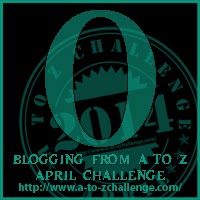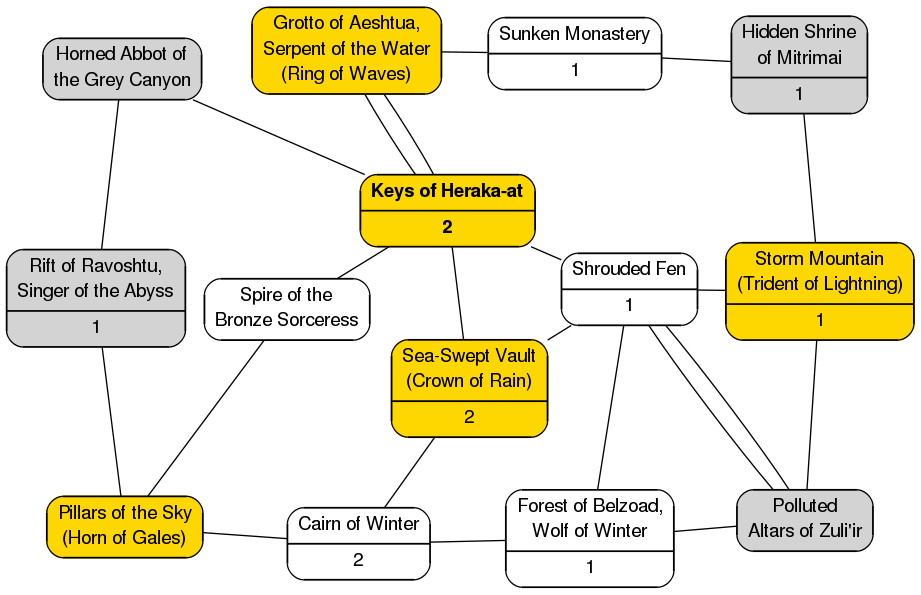 I’ve been asked on Google+ if it is really necessary to do all of this work making graphs and thinking about things far away from the adventure I’m actually working on.
I’ve been asked on Google+ if it is really necessary to do all of this work making graphs and thinking about things far away from the adventure I’m actually working on.
My answer is, I suppose, a mix of “not really” and “it can help”.
Not Really
If I want to create a standalone adventure, I don’t have to think of what is outside it. I might make some vague references to fairly generic entities to help make it easier to fit into an existing campaign (“a local temple”, “a powerful noble”, etc.), but that’s about as far as I might go. The very nature of standalone adventures is that they don’t connect to anything.
On the other side, I know people who can design adventures of some complexity and interconnectedness without the graphs and multiple layers of relationships and so on. I think either internally they are still doing much as I am in this series of posts, but simply aren’t capturing the thoughts to paper, or they are introducing elements that may or may not be followed up on.
I used to do a mix of the two. I’d give some thought to possible links, identify them in the (rudimentary) prep that I did, and present them in play. If the players followed up on them, great, if not, that was okay too. It worked well enough, but it always felt a bit slipshod to me. I knew I was overlooking relationships and forgetting themes that could have been reinforced and strengthened the campaign.
Standalone or ongoing, many people can get by without going to the degree of effort shown here. Given more time to invest in campaign and scenario development I can get by without it, but don’t know that I do as good a job.
It Can Help
I find that the methods I’m demonstrating really help me. The multiple layers of design give me a structure and framework to work in, and help give me ideas for directions to take things. I am looking somewhat far away from what I’m ‘actually working on’, and it allows me some wonderful abilities to telegraph and hint at what is (or may be) coming.
Documenting things at the graph and summary level is very helpful as well. Even a sentence or two per item, plus the graph, let me capture ideas for later (that may or may not be used, true) that I would otherwise likely forget. At the same time, apparently in contradiction, it lets me deliberately forget, or at least not think about, things I don’t need to deal with right away. When I start working with an element I can review the pieces I expect to be related, be it at the same level or higher, and pick the ones I want to involve. Everything else can be ignored.
For example, yesterday’s post shows that the The Keys of Heraka-at should probably have references to
- the Ring of Waves,
- the Grotto of Aeshtua, Serpent of the Water (location of the Ring of Waves),
- the Shrouded Fen (this is likely to change, as a hub I think I’d like something more informational, or at least drier and easier to travel through),
- the Trident of Lightning,
- Storm Mountain (location of the Trident of Lightning),
- the Crown of Rain,
- the Sea-Swept Vault (location of the Crown of Rain),
- the Horn of Gales,
- one or both of
- the Pillars of the Sky (location of the Horn of Gales),
- Spire of the Bronze Sorceress (shortest route to the Pillars of the Sky, and may provide direction)
There may also be some indication of where the treasures have to go and what to do with them, and what follows after that in order to become the Donnerkonig. These may or may not be adequate direction for finding or doing these things. Some might be pretty clear and straightforward (“go here to find the Grotto of Aeshtua, Serpent of the Water and guardian of the Ring of Waves. She lives underwater but loves barbecue, take ribs. With extra sauce.”), others might be less so (“Seek out the Bronze Sorceress, who may share knowledge needed to gain the Horn of Gales”). Some might not even make sense until additional knowledge is found, but I think I won’t include any of those.
When I work on any particular part of The Keys of Heraka-at I can review this list to see what I want to make reference to. I will probably have associated items referenced together, such as the Ring of Waves and the Grotto of Aeshtua, or that the Shrouded Fen might be a good approach to Storm Mountain/Trident of Lightning and the Sea-Swept Vault/Crown of Waves. Because I know more about the relationships and situations involved, I can plan better how I want to present the information.
Without the graphs I would likely have a harder time of it simply because I would tend to forget or overlook things.
The graphs also allow me to examine the connectivity and paths between the entities. There should always be a path, if not forward, then at least somewhere useful. Branches provide options to advance toward the goal, ‘leaves’ (leaf nodes in the graph, those with only a single connection) are a good place for optional material. If I find I have critical material in hard to reach (or worse, hard to find) locations, I can easily see now and correct now by adding or changing some edges. For instance, at one point I had one of the treasures at the location now marked ‘Hidden Shrine of Mitrimai’. This has only two immediate edges, both of which require three steps from The Keys of Heraka-at. That node could be pretty hard to get at, so I moved the treasure and put a campaign gateway there instead.
(I just noticed I italicize The Keys of Heraka-at, Donnerkonig Heirs, and Return of the Donnerkonig, but not the names of the other nodes. I suspect this is because these are working titles rather than placeholders in the diagrams. I find this curious.)
Closing Comments
Some, probably many, adventure designers and DMs can do their job without using processes such as I am describing, or can do it largely in their heads. I no longer have the time or mental capacity to do that, so I find that these processes help me coordinate, segment, and document my thoughts so I can minimize the mental space they occupy and provide structure to help me remember things.
If I were simply doing this for myself to prepare for play, I probably would have been able to do the critical pieces of this post and the last four in one evening.
- Campaign graph, Donnerkonig Heirs and Return of the Donnerkonig… stuff before, after, besides, exists, throw some nodes in to represent them, move on. They can be identified when I develop other pieces.
- Adventure graph for Donnerkonig Heirs, identify the node to be The Keys of Heraka-at, the locations of the treasures, and the other two immediate neighbors of Keys so I know what to hint at — the players will need information to make their decisions with. Physical placement on the map can wait.
- Encounter graph for The Keys of Heraka-at. I haven’t started this yet, but I know have quite a good idea what will need to be in it. I know that I can have backup plans in the adventures after this so I don’t have to be too heavy-handed with the hints or worry too much if the players miss one or two. They should still have enough available to make progress.
Most of the above can be taken to the level of detail I would need fairly quickly. The documentation shown so far is overkill for me running a campaign, but simply presenting the artifacts of the process would not be a very good demonstration of the process because of how many gaps I would leave. I am in fact spending more time documenting the process than I would in documenting the content. In reality I would do the graphs so I have an idea of the relationships, then fill in the blanks as I come to them. Each of the graphs is, in practice, likely to be quite sparse unless and until it looks like I will need to know. Being a demonstration, I am fleshing things out rather more than I normally would, and explaining what I am doing.

A couple thoughts on making the Shrouded Fen more informational and/or easier to get through:
Making travel easier is actually quite simple, as it isn’t strange for fens to either have open water or relatively dry paths, (or even both). If you allow people to mess with things, these sorts of things are even more likely, (do you follow the canal for speed, or slog through the mire to avoid interception?).
It also wouldn’t be that hard to put information sites within/near the fen: The Fenlands in England include such things as Ely Cathedral and Cambridge. If you don’t want your players slogging through a wetland just to get questions answered: Drain part of it, people will still call the area “the Shrouded Fen” even if the only part that is still a fen is the bit that the local druids are willing to kill to protect, (and guess who knows where the Sea-Swept Vault is?).
Both of those entirely make sense. For some reason I was seeing it as being fairly homogeneous, even though I know I would put other sites within the Fen.
Well I for one am very appreciative that you have decided to go into overkill.
I’m glad you’re enjoying it. Actually working through the process and describing it is highlighting for me things that could use some polish.
Pingback: Preparation and Player Agency in the Sandbox | Keith Davies — In My Campaign - Keith's thoughts on RPG design and play.